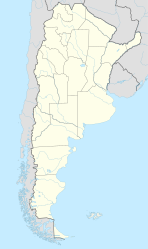Bahía Blanca
| Bahía Blanca | |||
|---|---|---|---|

Bahía Blanca Skyline
|
|||
|
|||
| Location in Argentina | |||
| Coordinates: 38°43′S 62°16′W / 38.717°S 62.267°WCoordinates: 38°43′S 62°16′W / 38.717°S 62.267°W | |||
| Country |
|
||
| Province |
|
||
| Partido | Bahía Blanca | ||
| Founded | 1828 | ||
| Government | |||
| • Intendant | Héctor Gay | ||
| Area | |||
| • Total | 2,247 km2 (868 sq mi) | ||
| Elevation | 20 m (70 ft) | ||
| Population (2010 census [INDEC]) | |||
| • Total | 301,572 | ||
| • Density | 130/km2 (350/sq mi) | ||
| CPA Base | B 8000 | ||
| Area code(s) | +54 291 | ||
| Climate | Cfa | ||
| Website | Official website | ||
Bahía Blanca (Spanish pronunciation: [ba.ˈi.a ˈβlaŋ.ka]; English: White Bay) is a city in the south-west of the province of Buenos Aires, Argentina, by the Atlantic Ocean, and is the seat of government of Bahía Blanca Partido. It had 301,572 inhabitants according to the 2010 census [INDEC]. It is the principal city in the Greater Bahía Blanca urban agglomeration.
The city has an important sea port with a depth of 45 feet (15 m), kept constant upstream almost all along the length of the bay, where the Naposta Stream drains.
Bahía Blanca means "White Bay". The name is due to the typical colour of the salt covering the soils surrounding the shores. The bay (which is actually an estuary) was seen by Ferdinand Magellan during his first circumnavigation of the world on the orders of Charles I of Spain, in 1520, looking for a canal connecting the Atlantic to the Pacific Ocean along the coasts of South America.
The city was founded as a fortress on 11 April 1828 by Colonel Ramón Estomba under the orders of Brigadier-General and subsequent Governor of Buenos Aires, Juan Manuel de Rosas, being named Fortaleza Protectora Argentina (Argentine Protective Fortress), intended to protect inhabitants from cattle rustlers, and also to protect the coast from the Brazilian navy, which had landed in the area the previous year. It was visited by Charles Darwin during his travels through South America in September 1833. The fortress was attacked by malones (incursions of nomadic aboriginals on horseback) several times, most notably in 1859 by 3,000 Calfucurá warriors. It became commercially important after the Buenos Aires Great Southern Railway linked the town to the city of Buenos Aires in 1885, facilitating the transport of grain from the Pampas.
...
Wikipedia


